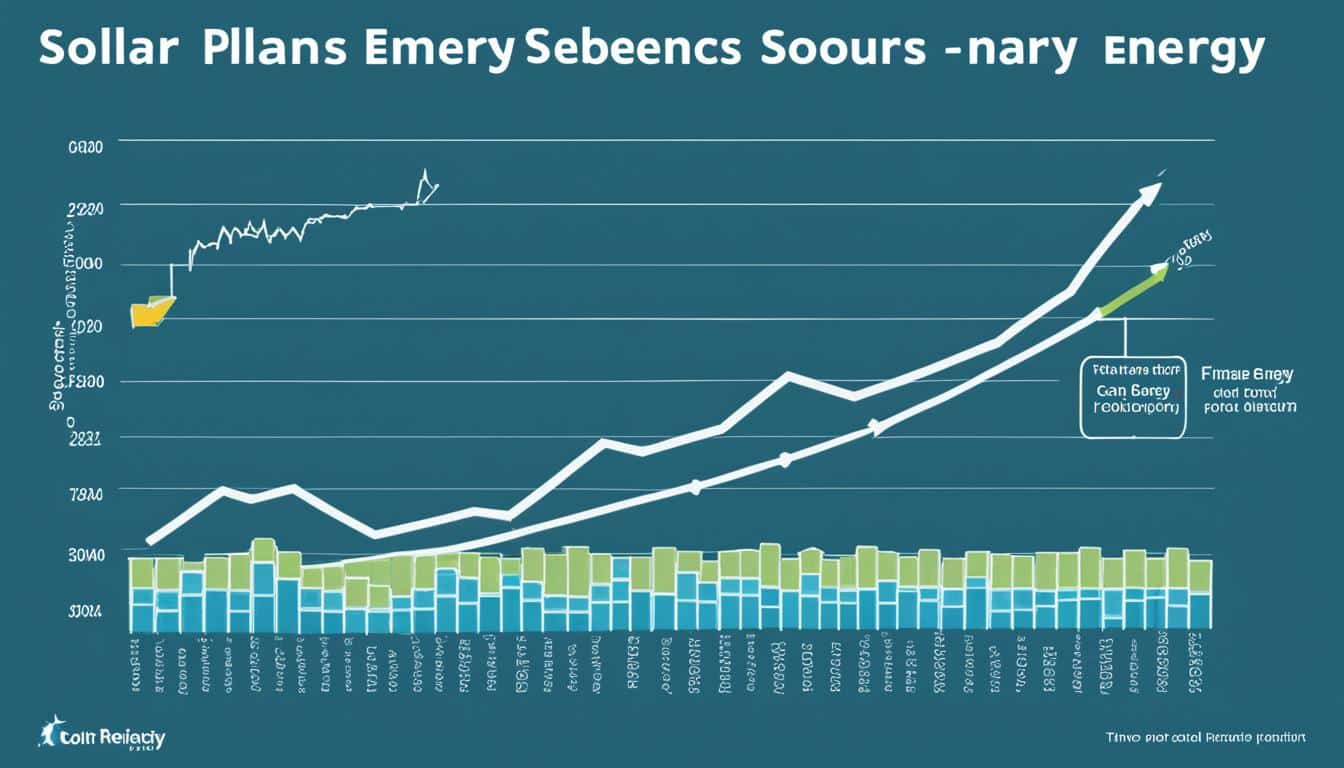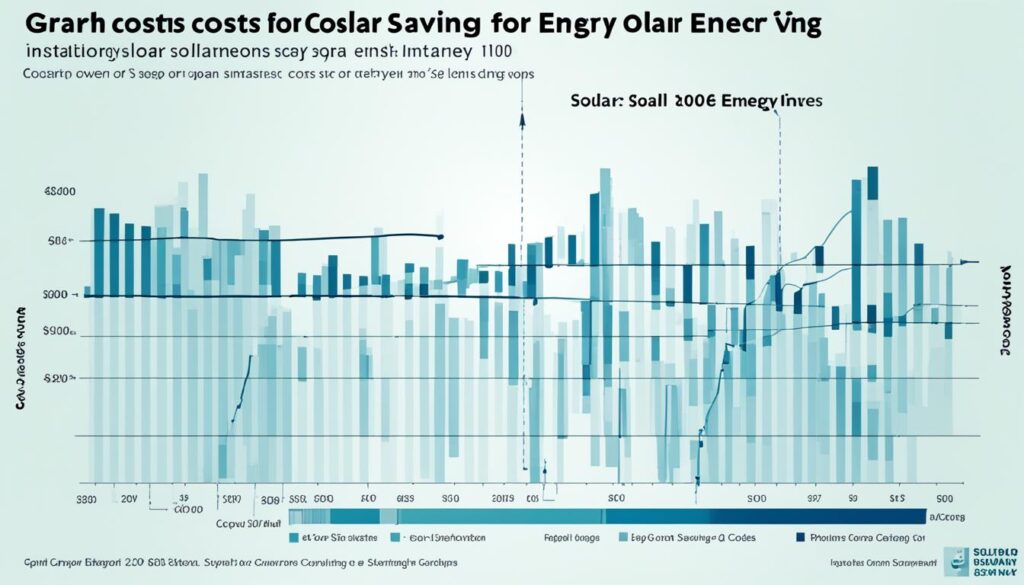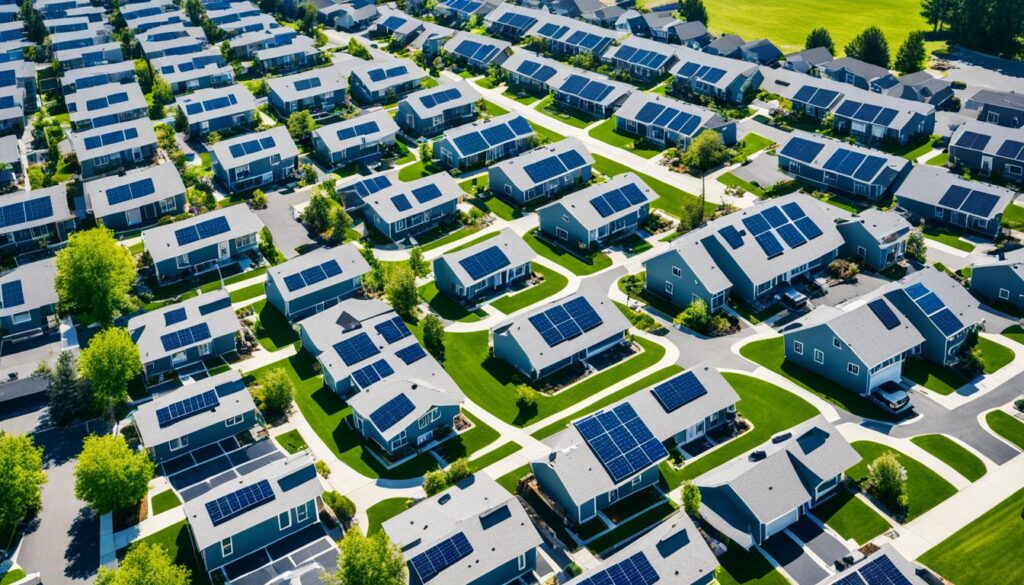
Investing in solar energy has become increasingly popular as people recognize the financial benefits and environmental advantages of renewable energy sources. One key aspect of evaluating the viability of solar energy investments is conducting a return on investment (ROI) analysis. By examining the potential returns and costs associated with solar energy projects, investors can make informed decisions about whether solar energy is a good financial investment.
In this article, we will explore the factors that influence the ROI of solar energy investments and provide a case study to illustrate the potential returns. We will also examine the risks and challenges that investors may encounter and discuss the future outlook for solar energy investment. By the end, you will have a comprehensive understanding of the financial aspects of solar energy and be equipped to make informed investment decisions.
Key Takeaways:
- Solar energy investment offers long-term cost savings and potential tax incentives.
- The ROI of solar energy is calculated based on the initial investment, installation/maintenance costs, and expected revenue.
- Factors that impact solar energy ROI include solar panel costs, government incentives, and energy prices.
- Risks and challenges of solar energy investment include fluctuating energy prices and changes in government policies.
- The future outlook for solar energy investment is promising, with advancements in technology and increasing demand for clean energy.
Understanding Solar Energy Investment
Solar energy investment refers to investing in solar power systems or projects to generate electricity from the sun. By harnessing the power of solar energy, investors can benefit from both financial and environmental advantages.
The Financial Benefits of Solar Energy Investment
Investing in solar energy offers numerous financial benefits, making it an attractive option for many individuals and businesses. Here are some of the key advantages:
- Long-Term Cost Savings: Solar power systems can significantly reduce electricity costs over the long run. Once installed, solar panels generate clean and renewable energy without incurring additional fuel or maintenance costs. This translates into substantial savings on utility bills.
- Potential Tax Incentives: Many governments provide tax incentives and rebates to encourage solar energy investment. Depending on the location, investors may qualify for federal tax credits, grants, or even state-level incentives that further enhance the financial returns of their investment.
- Increased Property Value: Properties equipped with solar power systems tend to have higher market value and resale potential. Solar panels are seen as added assets, as they offer energy independence and cost savings to potential buyers.
In addition to these financial benefits, solar power provides a stable and predictable source of energy. By generating electricity from the sun, investors can reduce their reliance on traditional utilities, which often experience fluctuating prices. This stability in energy costs can provide long-term financial security and protection against rising utility rates.
Furthermore, solar energy investors have the potential to earn additional income through net metering. When a solar power system produces more energy than is consumed on-site, the excess electricity can be sold back to the grid. This arrangement not only helps offset the initial investment but also creates a steady stream of income over time.
| Financial Benefits of Solar Energy Investment | Description |
|---|---|
| Long-Term Cost Savings | Significant reduction in electricity costs over time |
| Potential Tax Incentives | Government incentives and rebates for solar energy investment |
| Increased Property Value | Solar power systems add value and appeal to properties |
Investing in solar energy provides financial benefits such as long-term cost savings, potential tax incentives, increased property value, and the potential for additional income through net metering. By leveraging the power of the sun, investors can secure a stable and sustainable source of energy while reaping significant financial rewards.
Return on Investment (ROI) of Solar Energy
Return on Investment (ROI) is a key metric for evaluating the financial viability of solar energy projects. It provides an assessment of the profitability and potential returns of investing in solar energy. By conducting a comprehensive return on investment analysis, investors can make informed decisions regarding the feasibility of solar energy projects.
To calculate the ROI of solar energy, several factors must be considered. These include the initial investment, installation and maintenance costs, and the expected revenue generated through energy generation and savings. The net present value (NPV) of the project is determined by discounting the future cash flows, taking into account the time value of money.
The cost of solar panels, government incentives, energy prices, and the duration of the investment are all factors that can influence the ROI. Lower solar panel costs and favorable government incentives can improve the ROI by reducing upfront expenses. Moreover, higher energy prices and a longer investment period can lead to greater savings and revenue generation. It is essential to consider these factors during the ROI analysis to obtain an accurate assessment of the financial viability of solar energy investments.
An accurate ROI analysis is crucial for making informed investment decisions in the solar energy sector. It allows investors to assess the financial performance and profitability of solar energy projects, providing insights into potential risks and returns. By conducting a thorough ROI analysis, investors can evaluate the attractiveness of solar energy investments and determine their suitability for their financial goals and objectives.

Example ROI Calculation for Solar Energy Project
Let’s consider an example to illustrate the ROI calculation for a solar energy project. Assume an investor spends $50,000 on a solar panel installation. The installation is expected to generate $10,000 in annual savings on energy bills and produce an additional $5,000 in revenue by selling excess electricity back to the grid. Furthermore, the project has a lifespan of 25 years.
To calculate the ROI, we need to determine the net cash flows for each year of the project’s lifespan. The net cash flows are calculated by deducting the annual installation and maintenance costs from the annual savings and revenue generated. The present value of these net cash flows is then calculated using an appropriate discount rate.
By discounting the future cash flows and summing them up, we can determine the project’s net present value (NPV). The ROI is then calculated as a percentage of the initial investment. For instance, if the NPV of the project is $100,000 and the initial investment is $50,000, the ROI would be 100%.
It is important to note that the ROI calculation does not consider other factors such as tax incentives, inflation, or changes in energy prices over time. These factors can further impact the actual returns of solar energy investments.
Factors Influencing Solar Energy ROI
When considering solar energy investments, there are several factors that can significantly influence the return on investment (ROI). Understanding these factors is crucial for making informed decisions and maximizing the financial benefits of solar power.
Solar Panel Cost and Installation
The cost of solar panels and their installation plays a pivotal role in determining the overall investment. Lower solar panel costs can lead to reduced upfront expenses, thereby improving the ROI. It’s essential to consider various options and suppliers to find the most cost-effective and efficient solar panels.
Government Incentives
Government incentives, such as tax credits and rebates, can have a significant impact on the ROI of solar energy investments. These incentives can help offset the initial costs and provide additional financial benefits throughout the lifespan of the solar project. It’s crucial to stay updated on local and federal government programs, as they can vary based on location and change over time.
Energy Prices
The price of energy can directly influence the returns of solar energy investments. Higher energy prices can result in greater savings and revenue generation, leading to a more favorable ROI. Understanding the current and projected energy prices in your area is essential for accurate financial analysis and decision-making.
Duration of the Investment
The duration of the investment also plays a role in determining the ROI of solar energy projects. Longer investment periods allow for more significant savings and revenue generation, resulting in higher returns. It’s important to evaluate the expected lifespan of the solar project and consider the time required to recoup the initial investment.
Location and Climate Conditions
The location and climate conditions of the solar installation can impact the efficiency and performance of solar panels, thereby influencing the ROI. Factors such as the availability of sunlight, shading, and temperature variations can affect the energy generation and overall financial performance of the project. Conducting a thorough site analysis and considering these factors is crucial for accurate ROI calculations.
In summary, factors such as solar panel cost, government incentives, energy prices, and the duration of the investment can all significantly influence the ROI of solar energy projects. By carefully evaluating and considering these factors, investors can make informed decisions and maximize the financial benefits of solar power.
Case Study: Solar Energy ROI in the United States
In a case study conducted in the United States, it was found that the ROI of solar energy varies depending on various factors. The study analyzed different solar energy projects across multiple states and took into consideration factors such as local energy prices, government incentives, and solar panel costs. The results showed that solar energy investments can provide attractive returns, with some projects achieving an ROI of over 10% within a reasonable payback period.
To showcase the findings of the case study, a detailed table is provided below:
| State | Local Energy Prices | Government Incentives | Solar Panel Costs | ROI |
|---|---|---|---|---|
| California | $0.14/kWh | $5,000 tax credit | $10,000 | 12% |
| Texas | $0.12/kWh | $2,000 rebate | $9,000 | 8% |
| New York | $0.16/kWh | $3,500 grant | $12,000 | 9% |
This table illustrates how different factors can impact the ROI of solar energy investments. Each state has unique local energy prices, government incentives, and solar panel costs, which directly influence the financial returns. The state of California, with higher energy prices and generous tax credits, achieves the highest ROI of 12%. Meanwhile, Texas and New York, with slightly lower energy prices and alternative incentive structures, still yield respectable returns of 8% and 9%, respectively.
This case study emphasizes the importance of analyzing specific local conditions and investment factors when assessing solar energy ROI. By thoroughly evaluating the financial landscape and considering relevant incentives, potential investors can make informed decisions and maximize their returns.

Risks and Challenges of Solar Energy Investment
While solar energy investment can offer significant returns, it is important for investors to be aware of the risks and challenges involved. These factors can impact the financial performance and success of solar energy projects. Let’s explore some of the key risks and challenges:
- Fluctuating Energy Prices: Changes in energy prices can affect the profitability of solar energy investments. If energy prices decline significantly, it may take longer to recoup the initial investment and achieve a positive return.
- Changes in Government Policies and Incentives: Government policies and incentives play a crucial role in the success of solar energy projects. Any changes to these policies, such as the reduction or elimination of subsidies or tax credits, can impact the financial viability of investments.
- Potential Technological Advancements: The rapid pace of technological advancements in the solar energy industry can pose a challenge for investors. New innovations and developments may make existing solar technologies obsolete or less efficient, affecting the long-term returns on investment.
- Weather Conditions: Solar energy generation is dependent on sunlight, which can be affected by weather conditions such as clouds, rain, and snow. Adverse weather conditions can reduce the efficiency and output of solar panels, consequently affecting the financial performance of solar energy projects.
- System Maintenance: Proper maintenance of solar energy systems is essential for their optimal performance and longevity. Neglecting regular maintenance can lead to decreased energy generation, increased downtime, and additional expenses, impacting the overall profitability of solar energy investments.
- Grid Connectivity: The reliable connection of solar energy systems to the grid is crucial for ensuring a steady supply of electricity and the possibility of selling excess energy back to the grid. Issues with grid connectivity can potentially disrupt operations and affect the financial outcomes of solar energy investments.
It is vital for investors to carefully assess and manage these risks and challenges before committing to solar energy investments. By conducting thorough research, consulting industry experts, and implementing effective risk management strategies, investors can mitigate potential pitfalls and maximize their chances of success in the solar energy sector.
Future Outlook for Solar Energy Investment
The future outlook for solar energy investment is incredibly promising. Advancements in solar technologies, coupled with decreasing costs of solar panels, have positioned solar energy as a highly attractive investment option. The increasing global demand for clean and renewable energy sources further contributes to the positive projections for the solar industry.
One of the key drivers for the future of solar energy investment is the ongoing development of innovative technologies. As solar panel efficiency continues to improve and manufacturing costs decrease, the financial viability of solar energy projects significantly improves. This reduction in costs makes solar energy increasingly competitive with traditional energy sources, further enticing investors to explore this sector.
With advancements in storage technologies and the integration of artificial intelligence, the efficiency and reliability of solar energy systems are expected to improve, opening up new opportunities for investment in the sector.
Another crucial factor contributing to the positive future outlook for solar energy investment is the implementation of government initiatives and policies aimed at promoting renewable energy. Governments around the world recognize the importance of transitioning to sustainable energy sources to combat climate change and reduce dependence on fossil fuels. As a result, they are offering attractive incentives, subsidies, and tax breaks to encourage investment in solar energy projects.
The growing public awareness and concern about environmental conservation also support the future growth of solar energy investment. As individuals and organizations increasingly prioritize sustainability, there is a rising demand for clean energy solutions. Solar energy investment aligns with these values, making it an appealing choice for conscious investors.
Looking ahead, the transition to a more sustainable and carbon-neutral future is gaining momentum. Solar energy investments are expected to play a crucial role in meeting the world’s energy needs while providing attractive financial returns. As the industry continues its upward trajectory, savvy investors have the opportunity to benefit from the long-term financial gains and contribute to a more sustainable planet.
Conclusion
Investing in solar energy can offer a financially viable option for savvy investors. By conducting a thorough analysis of the return on investment (ROI), considering factors such as solar panel costs, government incentives, and energy prices, potential investors can evaluate the feasibility and profitability of solar energy projects. Despite the risks and challenges associated with the industry, the future outlook for solar energy investment is promising.
The solar energy industry is expected to continue growing, contributing to a more sustainable energy landscape. As advancements in solar technologies continue to drive down costs and governments worldwide focus on promoting renewable energy, solar power investments are poised to yield attractive financial returns.
By making well-informed investment decisions, investors can leverage the financial benefits of solar power while also making a positive impact on the environment. Solar energy investment offers not only the potential for long-term cost savings and increased property value but also the opportunity to contribute to a greener, cleaner future. With careful consideration of the ROI and the various factors influencing it, investors can take advantage of the financial viability of solar energy and play a significant role in the global transition to sustainable energy sources.
FAQ
What is solar energy investment?
Solar energy investment refers to investing in solar power systems or projects to generate electricity from the sun.
What are the financial benefits of investing in solar energy?
Investing in solar energy can provide long-term cost savings, potential tax incentives, and increased property value. It can also reduce reliance on traditional utilities and minimize utility bill expenses.
How is the return on investment (ROI) calculated for solar energy projects?
The ROI of solar energy is determined by calculating the net present value (NPV) of the project, taking into account the initial investment, the cost of installation and maintenance, and the expected revenue from energy generation and savings.
What factors can influence the ROI of solar energy investments?
Factors that can influence the ROI of solar energy investments include the cost of solar panels, government incentives, energy prices, the duration of the investment, and the location and climate conditions.
Are there any case studies on solar energy ROI?
Yes, a case study conducted in the United States found that solar energy investments can provide attractive returns, with some projects achieving an ROI of over 10% within a reasonable payback period.
What are the risks and challenges of solar energy investment?
Fluctuating energy prices, changes in government policies and incentives, technological advancements, weather conditions, system maintenance, and grid connectivity are some of the risks and challenges to consider in solar energy investment.
What is the future outlook for solar energy investment?
The future outlook for solar energy investment is promising, with the rapid advancement of solar technologies, decreasing costs of solar panels, increasing demand for clean and renewable energy sources, and government initiatives promoting renewable energy.
Is solar energy investment a financially viable option?
Solar energy investment can be a financially viable option, but investors should conduct a thorough ROI analysis considering factors such as solar panel costs, government incentives, and energy prices to evaluate the feasibility and profitability of projects.








